Investigation of Quantitative Evaluation Method and Engineering Application of Shallow Buried Tunnel Face Stability
Abstract
:1. Introduction
2. Establishment of Wedge Sliding Body Model
2.1. Limit Equilibrium Model of Wedge Sliding Body
2.2. Stability Coefficient of Tunnel Face
2.3. Discrimination Method of Tunnel Face Stability
3. Quantitative Analysis of Support Effect of the Tunnel Face
3.1. Support Optimization System of the Tunnel Face
3.2. Strengthening Effect of Pipe Roofing Support
3.3. Strengthening Effect of Grouting Support
3.4. Strengthening Effect of Reserved Core Soil
3.5. Strengthening Effect of Bolting Support
4. Engineering Case Calculation
4.1. Engineering Geology Overview
4.2. Initial Stability Analysis of Tunnel Face
4.3. Optimization Analysis of Support Measures
4.4. On-Site Monitoring
5. Conclusions
- The quantitative analysis model of tunnel face stability is established based on the silo theory. The tunnel face stability discrimination and support optimization system is developed, which can rapidly determine tunnel face stability and then provide a quantitative evaluation method for the assessment of tunnel face safety.
- Based on the quantitative analysis model of tunnel face stability, the strengthening effect of different support schemes of the tunnel face is systematically analyzed. It can be found that the grouting support has the most significant effect on improving the tunnel face stability, followed by the reinforcement effect of an anchor bolt and reserved core soil, and the reinforcement effect of pipe roofing support has the worst effect. The reserved core soil is preferred for use as a support if the initial stability coefficient of the tunnel face cannot meet the stability requirements. Then, the reinforcement through the tunnel face grouting is more effective than other measures when the stability requirements are still not met.
- The tunnel surface stability of an underground rail transit tunnel passing through suburban expressway in Chongqing was analyzed based on the tunnel face stability discrimination and support optimization system. The optimization analysis of support measures successfully predicts the over-limit settlement of an auxiliary road of the left line. Then, the optimization scheme of pipe roofing support + reserved core soil + grouting support is finally formed considering the effect of support measures and construction difficulty. On-site monitoring shows that the farther from the tunnel face, the slower the cumulative displacement increases, and the smaller the maximum cumulative displacement. The settlement displacement after optimization is reduced to 15.50 mm, which is about 44.93% before the optimization of the reinforcement scheme, ensuring the safe construction of the suburban expressway.
Author Contributions
Funding
Institutional Review Board Statement
Informed Consent Statement
Data Availability Statement
Acknowledgments
Conflicts of Interest
References
- Dong, L.; Song, D.; Liu, G. Seismic wave propagation characteristics and their effects on the dynamic response of layered rock sites. Appl. Sci. 2022, 12, 758. [Google Scholar] [CrossRef]
- Fan, S.Y.; Song, Z.P.; Zhang, Y.W.; Liu, N.F. Case study of the effect of rainfall infiltration on a tunnel underlying the roadbed slope with weak inter-layer. KSCE J. Civ. Eng. 2020, 24, 1607–1619. [Google Scholar] [CrossRef]
- Fan, S.Y.; Song, Z.P.; Xu, T.; Wang, K.M.; Zhang, Y.W. Tunnel deformation and stress response under the bilateral foundation pit construction: A case study. Arch. Civ. Mech. Eng. 2021, 21, 109. [Google Scholar] [CrossRef]
- Tian, X.X.; Song, Z.P.; Zhang, Y.W. Monitoring and reinforcement of landslide induced by tunnel excavation: A case study from Xiamaixi tunnel. Tunn. Undergr. Space Technol. 2020, 110, 103796. [Google Scholar] [CrossRef]
- Tian, X.X.; Song, Z.P.; Wang, H.Z.; Zhang, Y.W.; Wang, J.B. Evolution characteristics of the surrounding rock pressure and construction techniques: A case study from Taoshuping tunnel. Tunn. Undergr. Space Technol. 2022, 125, 104522. [Google Scholar] [CrossRef]
- Zhu, C.; He, M.C.; Zhang, X.H.; Tao, Z.G.; Yin, Q.; Li, L.F. Nonlinear mechanical model of constant resistance and large deformation bolt and influence parameters analysis of constant resistance behavior. Rock. Soil. Mech. 2021, 42, 1911–1924. [Google Scholar]
- Zhu, C.; He, M.C.; Jiang, B.; Qin, X.Z.; Yin, Q.; Zhou, Y. Numerical investigation on the fatigue failure characteristics of water-bearing sandstone under cyclic loading. J. Mt. Sci. 2021, 18, 3348–3365. [Google Scholar] [CrossRef]
- Wu, K.; Shao, Z.S.; Qin, S.; Wei, W.; Chu, Z. A critical review on the performance of yielding supports in squeezing tunnels. Tunn. Undergr. Space Technol. 2021, 115, 103815. [Google Scholar] [CrossRef]
- Wu, K.; Shao, Z.S.; Sharifzadeh, M.; Hong, S.; Qin, S. Analytical computation of support characteristic curve for circumferential yielding lining in tunnel design. J. Rock Mech. Geotech. Eng. 2022, 14, 144–152. [Google Scholar] [CrossRef]
- Song, Z.P.; Song, W.X.; Cheng, Y.; Yang, T.T.; Wang, T.; Wang, K.S. Investigation on strain characteristics and fatigue constitutive model of limestone under osmotic pressure and cyclic disturbance coupling. KSCE J. Civ. Eng. 2021, 26, 1740–1753. [Google Scholar] [CrossRef]
- Cheng, Y.; Song, Z.P.; Jin, J.F.; Wang, T.; Yang, T.T. Waveform characterisation and energy dissipation of stress wave based on modified SHPB tests. Geomech. Eng. 2020, 22, 187–196. [Google Scholar]
- Cheng, Y.; Song, Z.P.; Chang, X.X.; Wang, T. Energy evolution principles of shock-wave in sandstone under unloading stress. KSCE J. Civ. Eng. 2020, 24, 2912–2922. [Google Scholar] [CrossRef]
- Yuan, W.; Jin, J.F.; Guo, Z.Q.; Wu, Y. Theoretical analysis of longitudinal wave attenuation in a stressed rock with variable cross-section. Front. Earth Sci. 2019, 7, 270–278. [Google Scholar] [CrossRef]
- Cheng, Y.; Song, Z.P.; Song, W.X.; Li, S.G.; Yang, T.T.; Zhang, Z.K.; Wang, T.; Wang, K.S. Strain performance and fracture response characteristics of hard rock under cyclic loading. Geomech. Eng. 2021, 26, 551–563. [Google Scholar]
- Li, P.F.; Zhao, Y.; Liu, J.Y. Deformation characteristics and control methods of tunnel soft surrounding rock. China Railw. Sci. 2014, 35, 55–61. [Google Scholar]
- Broms, B.B.; Bennermark, H. Stability of clay at vertical openings. J. Soil Mech. Found. Eng. 1967, 193, 71–94. [Google Scholar] [CrossRef]
- Potts, D.M.; Atkinson, J.H. Stability of a shallow circular tunnel in cohesionless soil. Geotechnique 1977, 27, 203–215. [Google Scholar]
- Anagnostou, G.; Kovári, K. Face stability conditions with earth-pressure-balanced shields. Tunn. Undergr. Space Technol. 1996, 11, 165–173. [Google Scholar] [CrossRef]
- Zhang, C.; Han, K.; Zhang, D. Face stability analysis of shallow circular tunnels in cohesive–frictional soils. Tunn. Undergr. Space Technol. 2015, 50, 345–357. [Google Scholar] [CrossRef]
- Li, T.; Yang, X. 3D rotational failure mechanism of tunnel face in weathered and saturated hoek-brown rock masses. KSCE J. Civ. Eng. 2019, 23, 2723–2732. [Google Scholar] [CrossRef]
- Liu, H.; Zhang, Y.; Liu, H. Failure mechanism of face for slurry shield-driven tunnel in sand. KSCE J. Civ. Eng. 2020, 24, 3105–3118. [Google Scholar] [CrossRef]
- Zheng, Y.R.; Qiu, C.Y.; Zhang, H.; Wang, Q. Exploration on stability analysis method of surrounding rock of soil tunnel. J. Rock Mech. Eng. 2008, 27, 1968–1980. [Google Scholar]
- Zhao, L.H.; Li, D.J.; Yang, F.; Li, L.; Cheng, X. Dimensionless parameter diagrams for the active and passive stability of a shallow 3D tunnel face. KSCE J. Civ. Eng. 2019, 23, 866–878. [Google Scholar] [CrossRef]
- Wu, K.; Shao, Z.; Sharifzadeh, M.; Chu, Z.; Qin, S. Analytical approach to estimating the influence of shotcrete hardening property on tunnel response. J. Eng. Mech. 2022, 148, 4021127. [Google Scholar] [CrossRef]
- Song, Z.P.; Tian, X.X.; Zhou, G.N.; Li, W.W. Theoretical analysis of mechanical behavior of advance presupport of pipe-roof protection in tunnel. China J. Highw. Transp. 2020, 33, 93–102. [Google Scholar]
- Wang, M.N.; Zhang, X.; Zhao, S.G.; Wang, Z.L.; Liu, D.G.; Tong, J.J. Study on design method of advance support system for mechanized full section construction of tunnel in soft surrounding rock. J. China Railw. Sci. 2020, 42, 146–154. [Google Scholar]
- Wang, X.Y.; Zheng, W.H.; Zhang, J.G.; Liu, W. Stability analysis of tunnel face pre strengthened with glass fiber bolt in soft rock tunnel. China Civ. Eng. J. 2017, 50, 53–58. [Google Scholar]
- Huang, W.X.; Wu, H.; Wang, J.; Xia, M. Comparative study on excavation sequence of tunnel in biased soft surrounding rock. J. Eng. Geol. 2019, 27, 277–285. [Google Scholar]
- Lai, H.P.; Kang, Z.; Xie, Y.L.; Gao, X.P. Study on grouting presupport technology in loess stratum of subway section tunnel. China Railw. Sci. 2014, 35, 47–54. [Google Scholar]
- Liang, Q.; Liu, J.; Wang, J.; Zeng, X.T.; Wu, S.G. Three-dimensional stability of cyclical footage area in tunnel face. KSCE J. Civ. Eng. 2022, 26, 955–965. [Google Scholar] [CrossRef]
- Anagnostou, G.; Serafeimidis, K. The dimensioning of tunnel face reinforcement. In Underground Space—The Dimension of Metropolises, Proceedings of the 33rd ITA-AITES World Tunnel Congress, Prague, Czech Republic, 5–10 May 2007; Taylor & Francis: Abingdon, UK, 2007. [Google Scholar]
- Oggeri, C.; Ova, G. Quality in Tunnelling. Tunn. Undergr. Space Technol. 2004, 19, 239–272. [Google Scholar] [CrossRef]
- Li, D.X.; Wang, E.Y.; Li, Z.H.; Ju, Y.Q.; Wang, D.M.; Wang, X.Y. Experimental investigations of pressure stimulated currents from stressed sandstone used as precursors to rock fracture. Int. J. Rock Mech. Min. Sci. 2021, 145, 104841. [Google Scholar] [CrossRef]
- Li, D.X.; Wang, E.Y.; Kong, X.G.; Ali, M.; Wang, D.M. Mechanical behaviors and acoustic emission fractal characteristics of coal specimens with a pre-existing flaw of various inclinations under uniaxial compression. Int. J. Rock Mech. Min. Sci. 2019, 116, 38–51. [Google Scholar] [CrossRef]
- GB 50330-2013; Republic of China Technical Code for Building Slope Engineering. China Construction Industry Press: Beijing, China, 2013.
- Chen, Z.; He, P.; Yan, D.M.; Gao, H.G.; Nie, A.X. Upper limit analysis of tunnel face stability under advanced support. Geotech. Mech. 2019, 40, 2154–2162. [Google Scholar]
- JTG/T D70-2010; Republic of China Detailed Rules for Highway Tunnel Design. Communications Press: Beijing, China, 2010.
- GB 50715-2011; Evaluation Standard of Metro Engineering Construction Safety. The Ministry of Housing and Urban-Rural Development: Beijing, China, 2011.
- Jiang, D.M.; Li, X.S.; Wang, Y.X.; Bian, Z.F.; Zhang, J.; Fan, H.P. Coordinating urban construction and coal resource mining based on equilibrium value between coal reserve and land resource in coal cities. Geomat. Nat. Haz. Risk. 2021, 12, 2865–2879. [Google Scholar] [CrossRef]
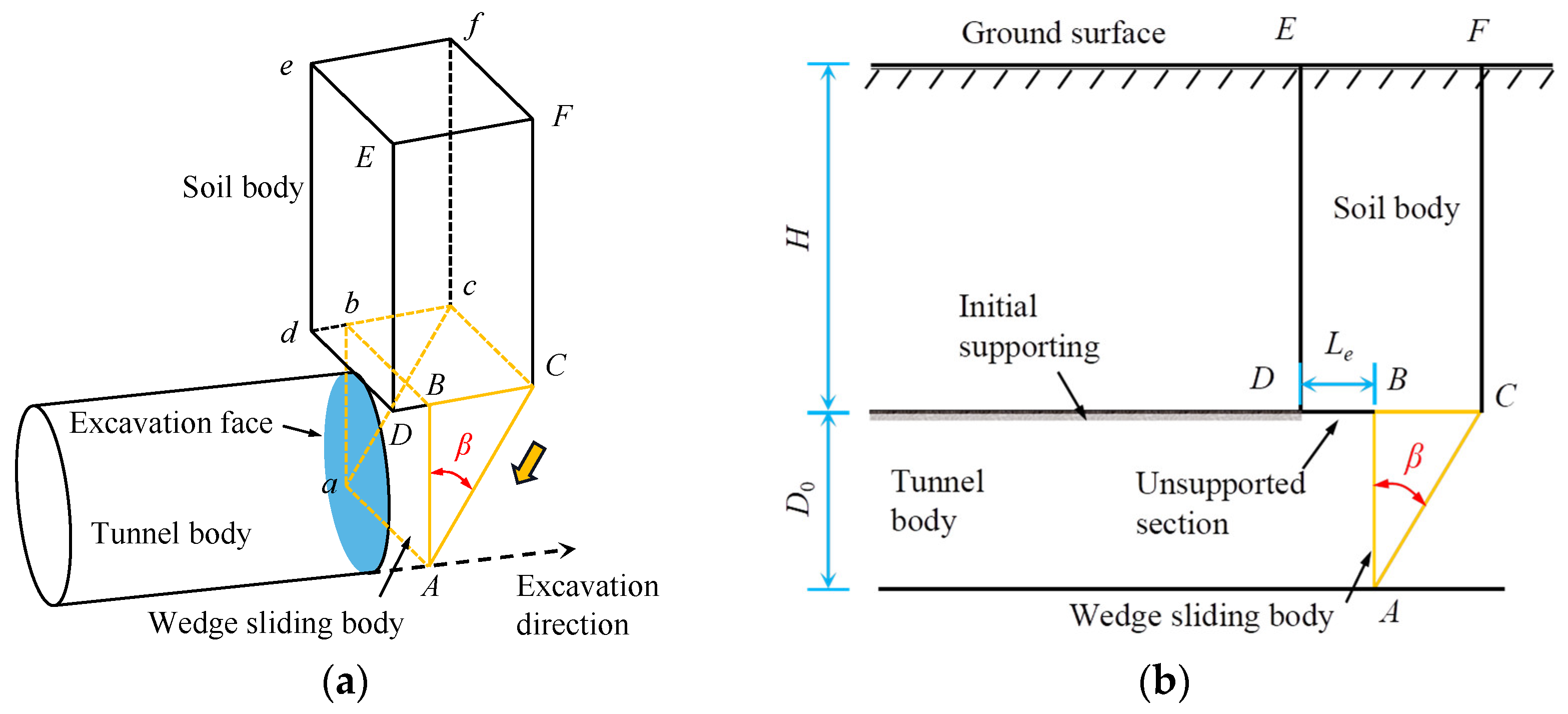
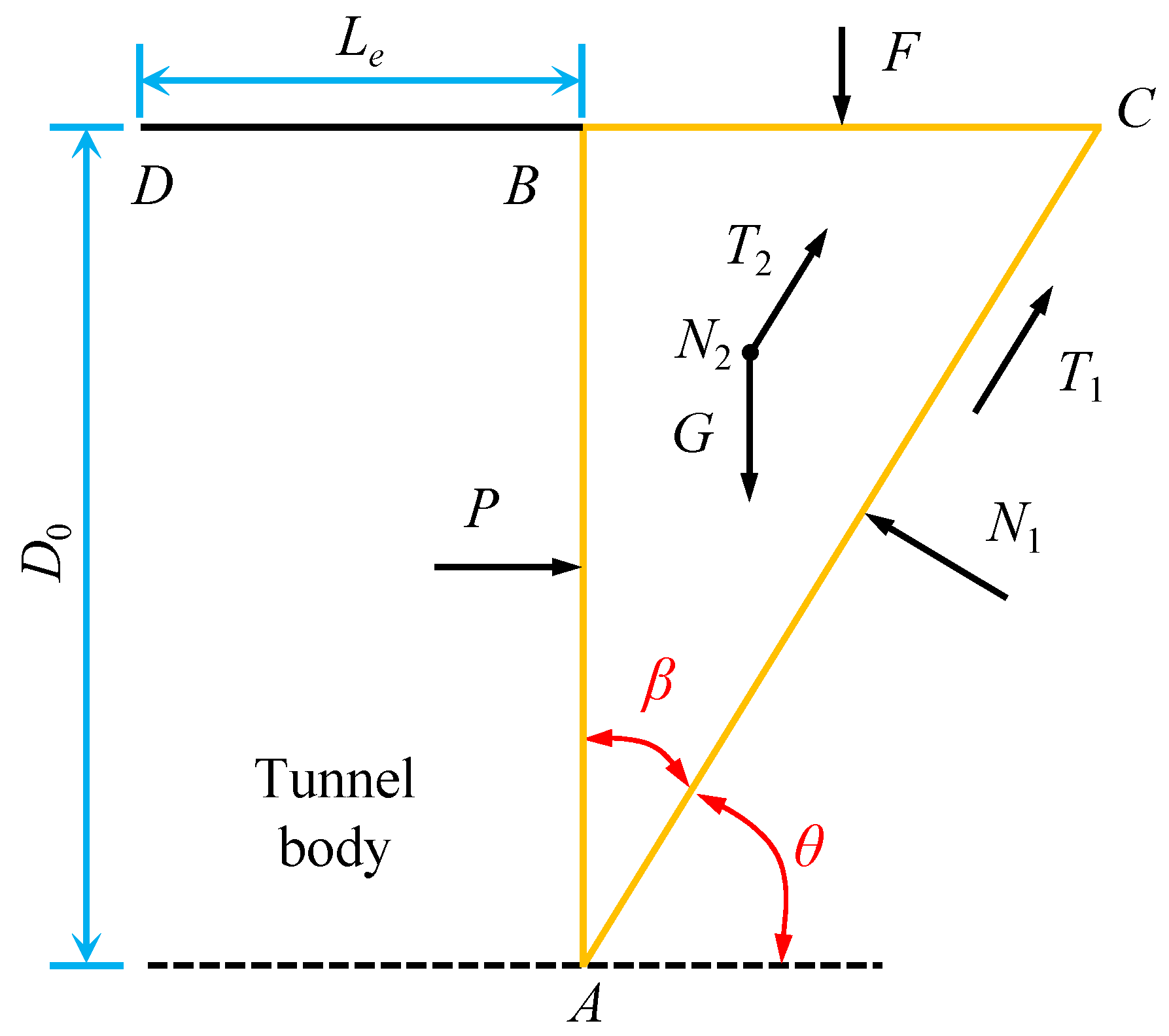


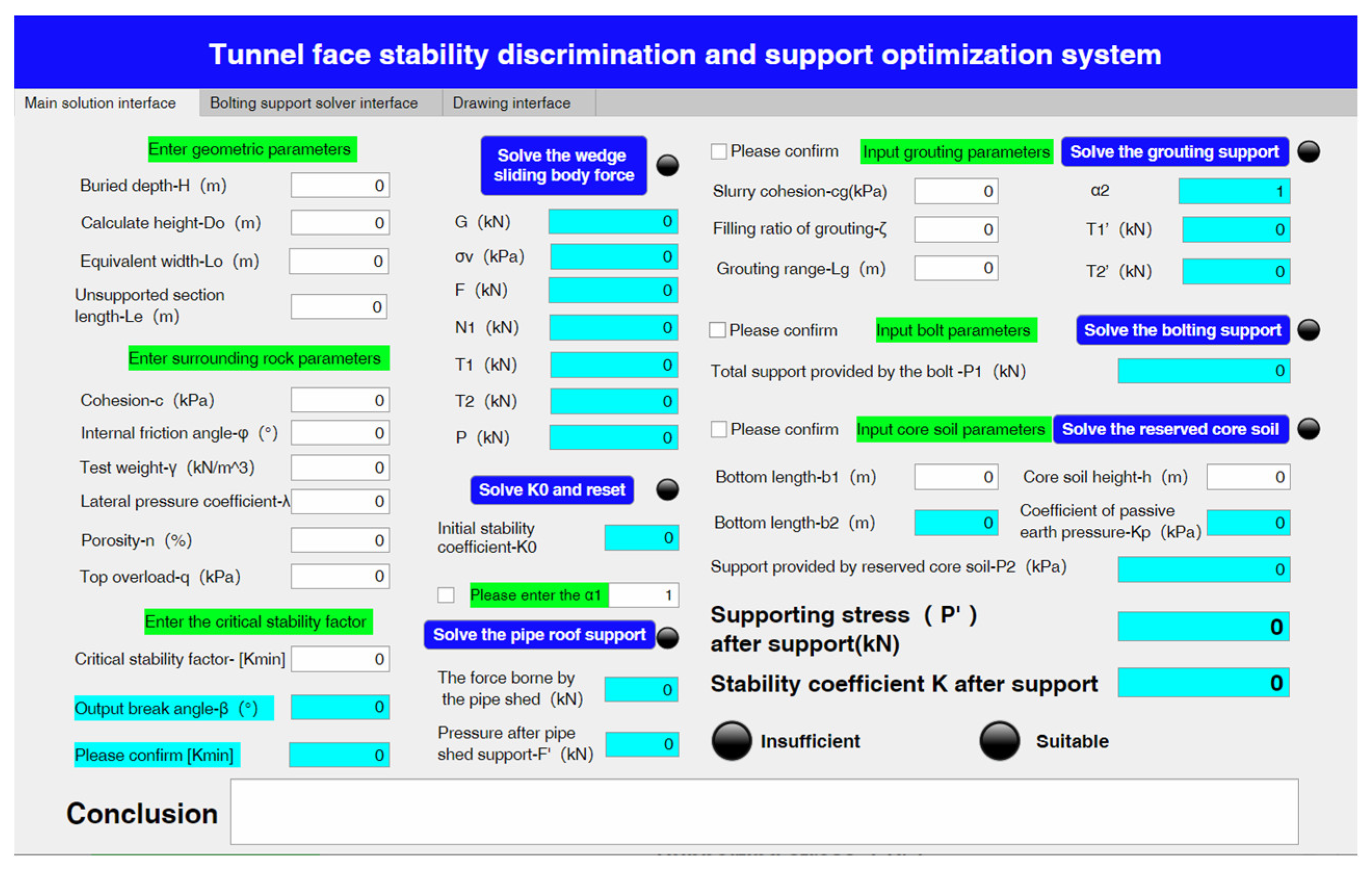
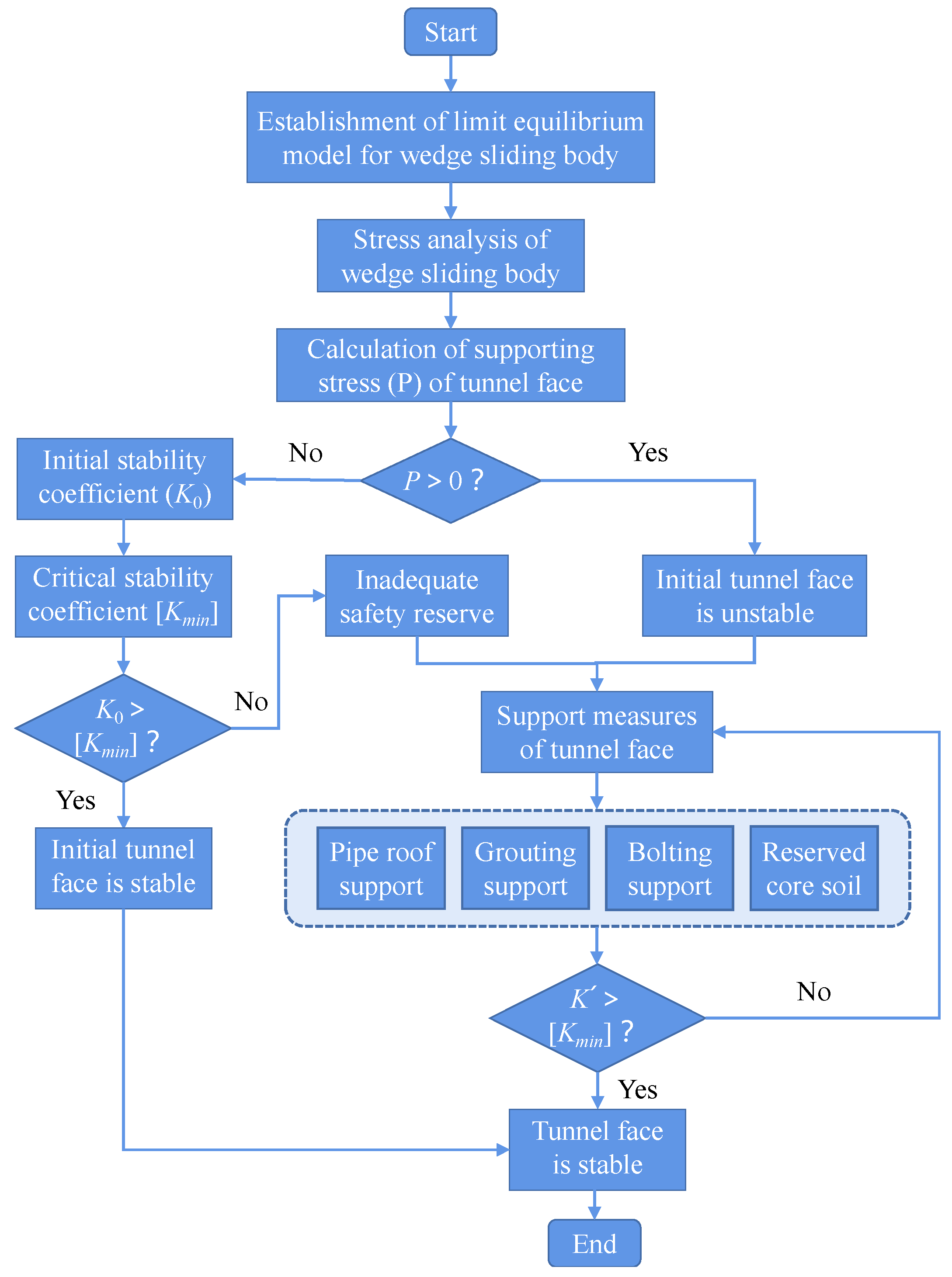
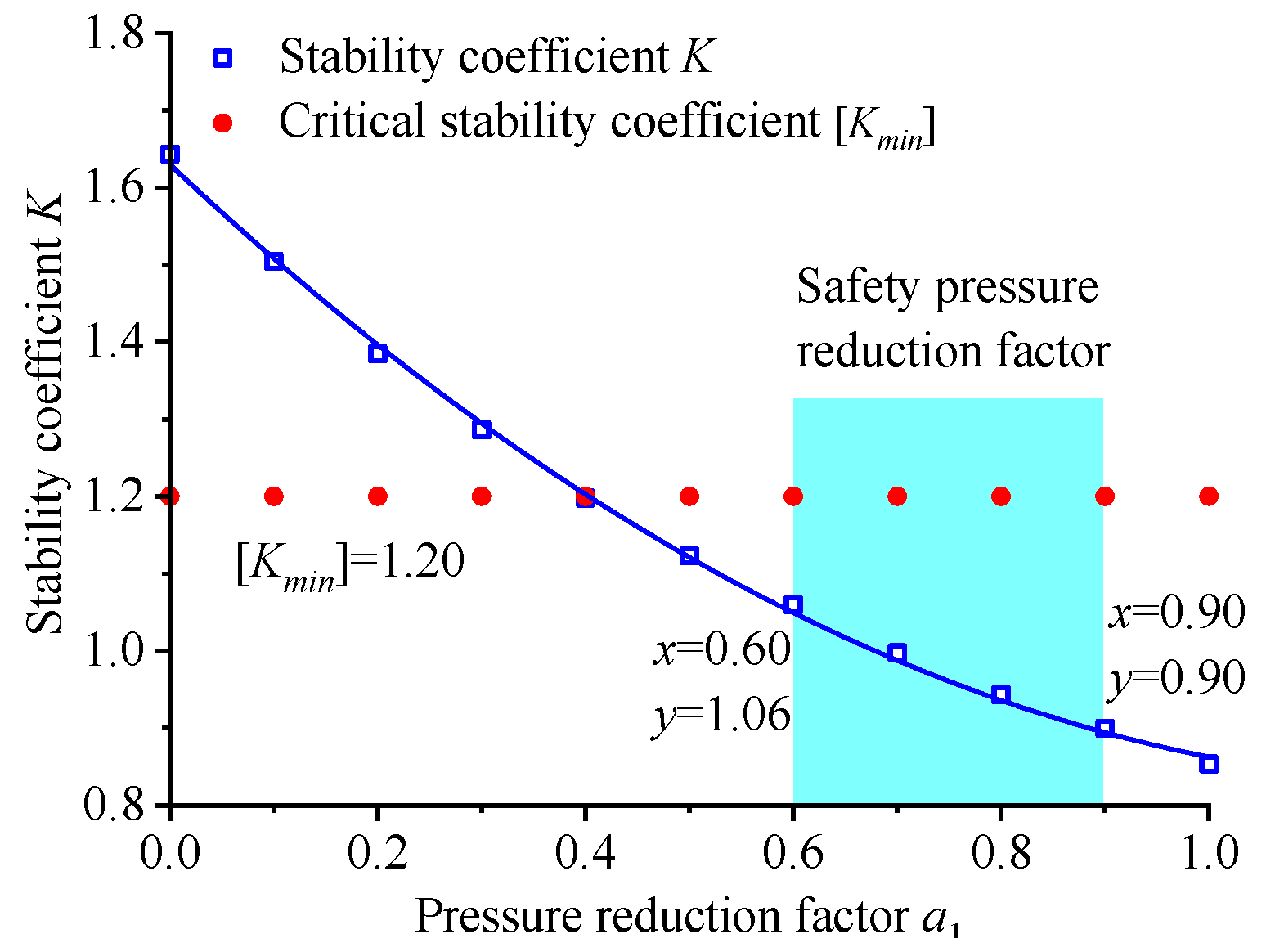
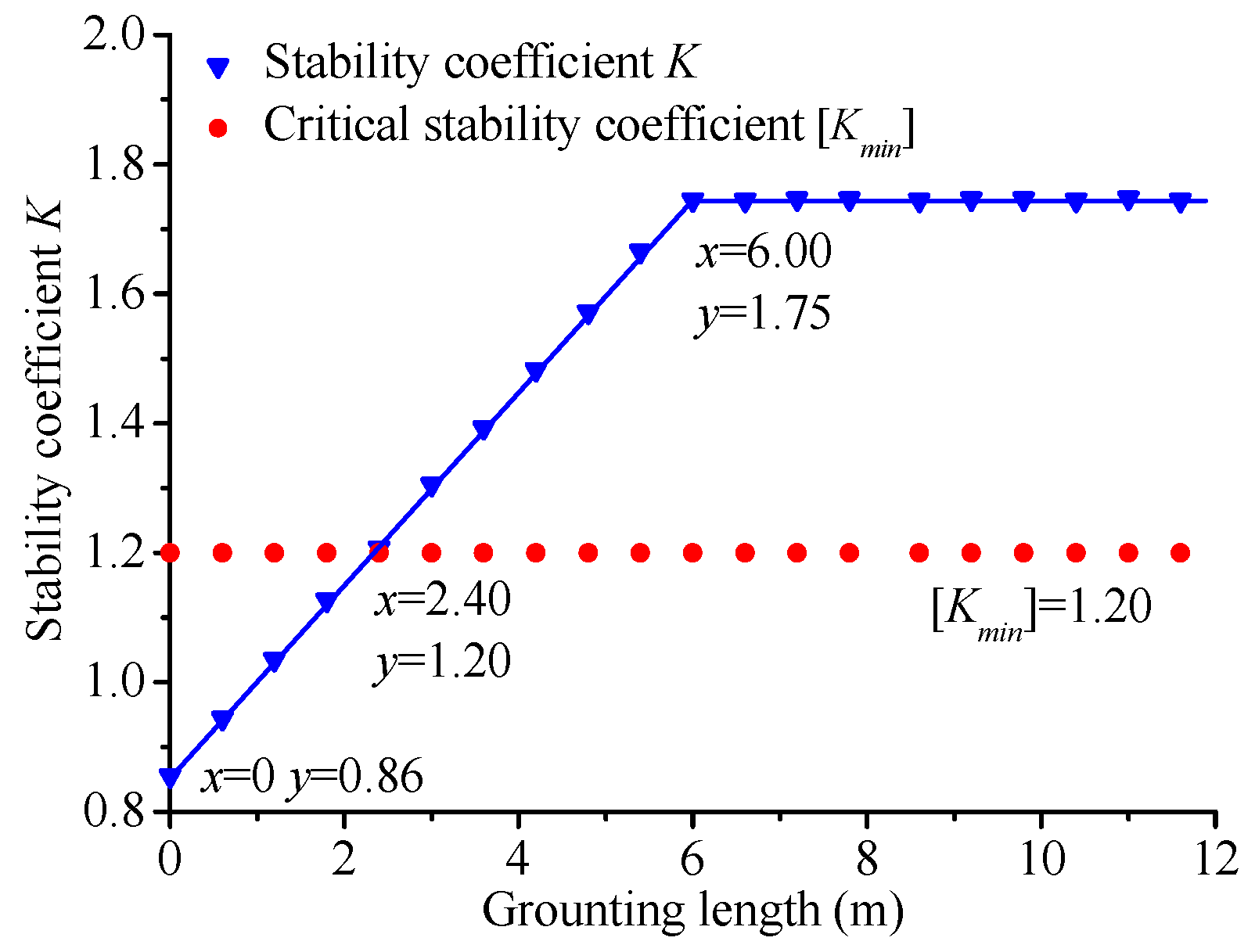
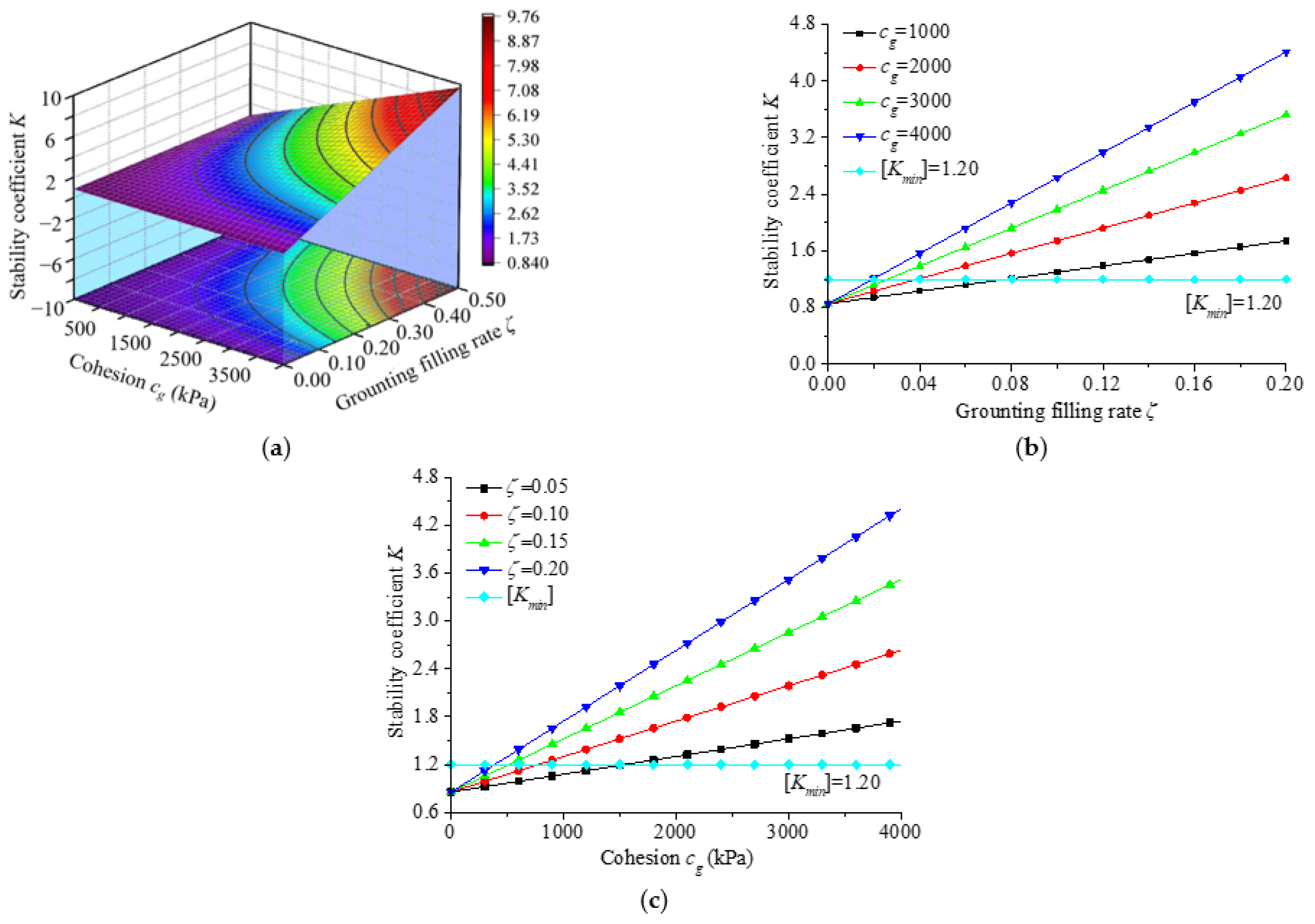

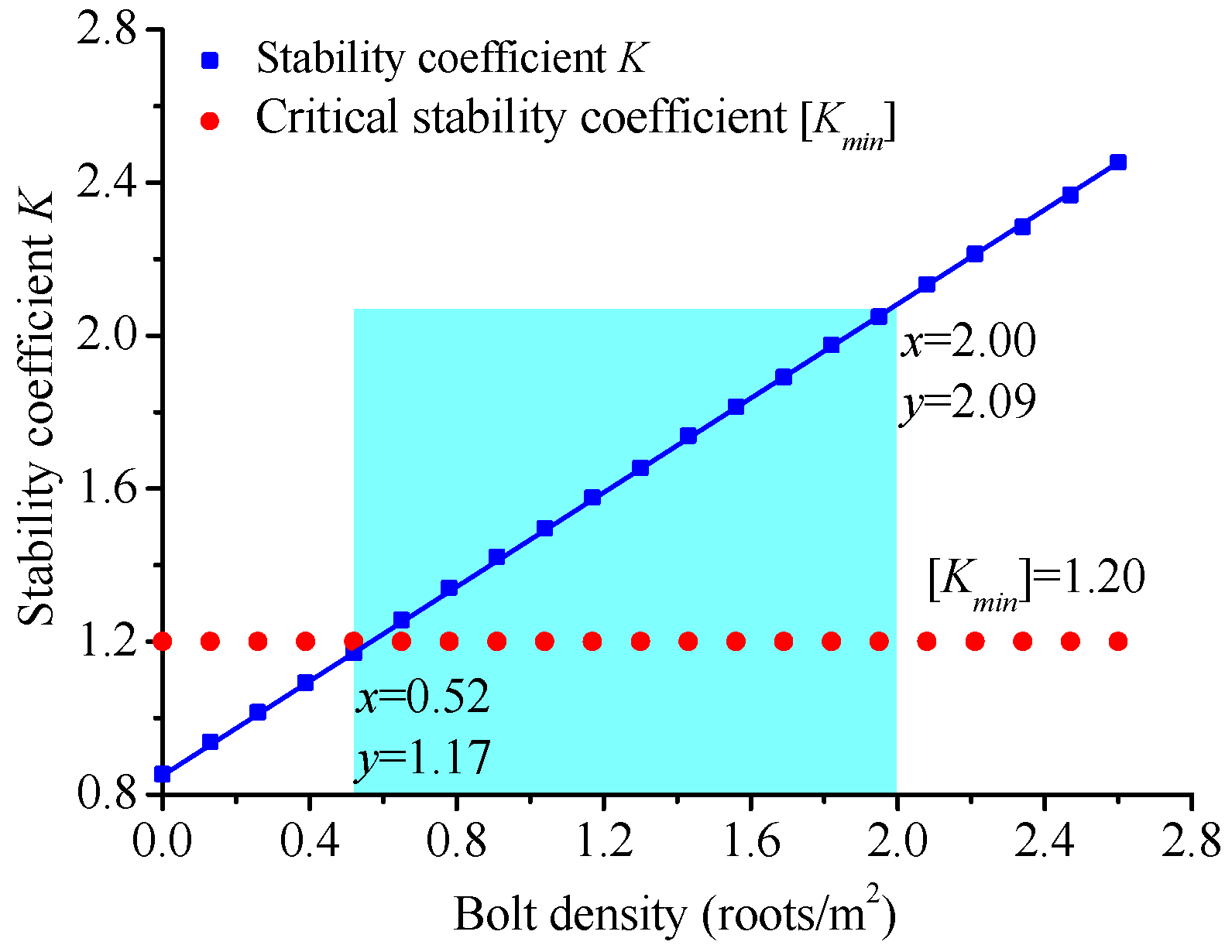
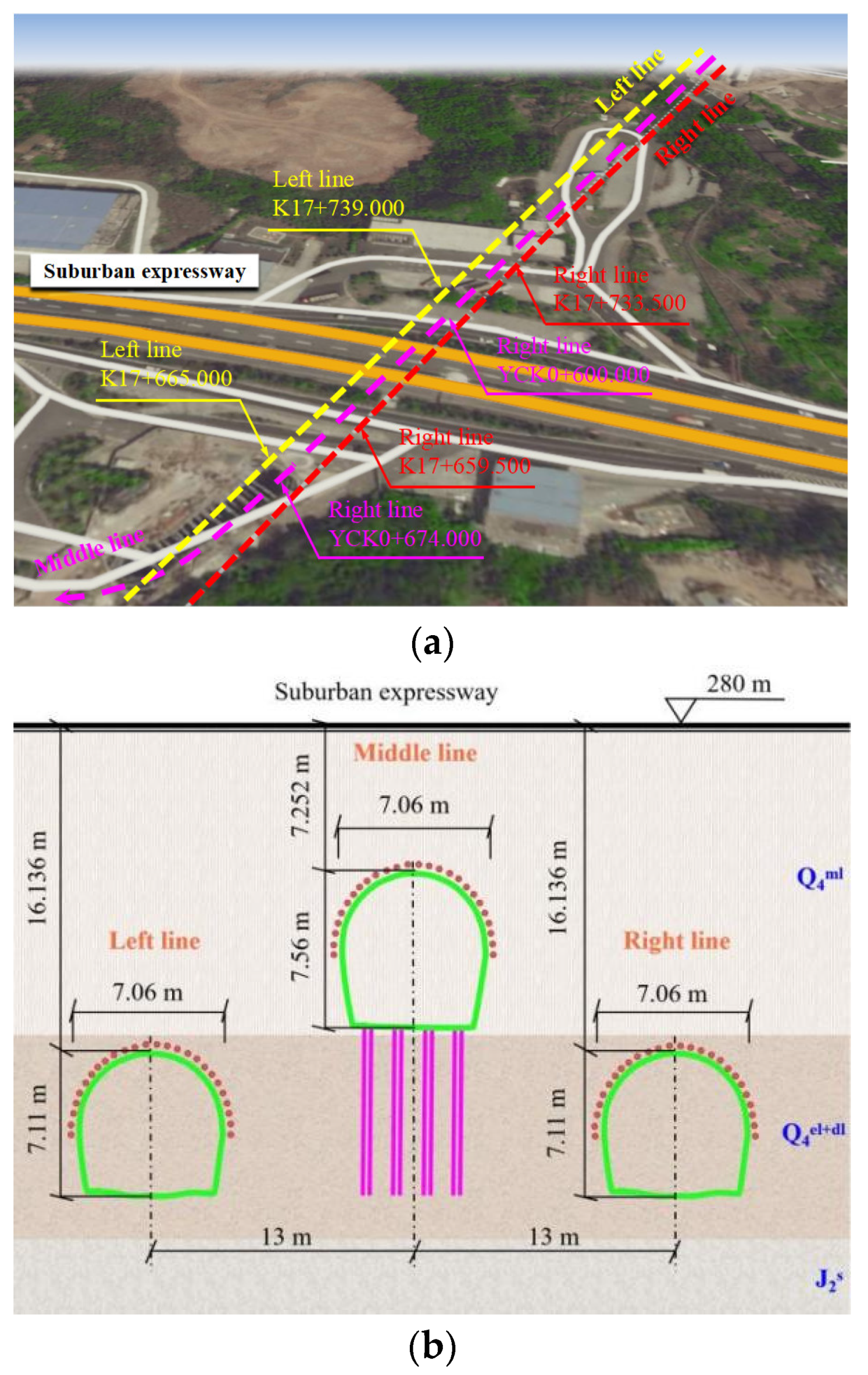

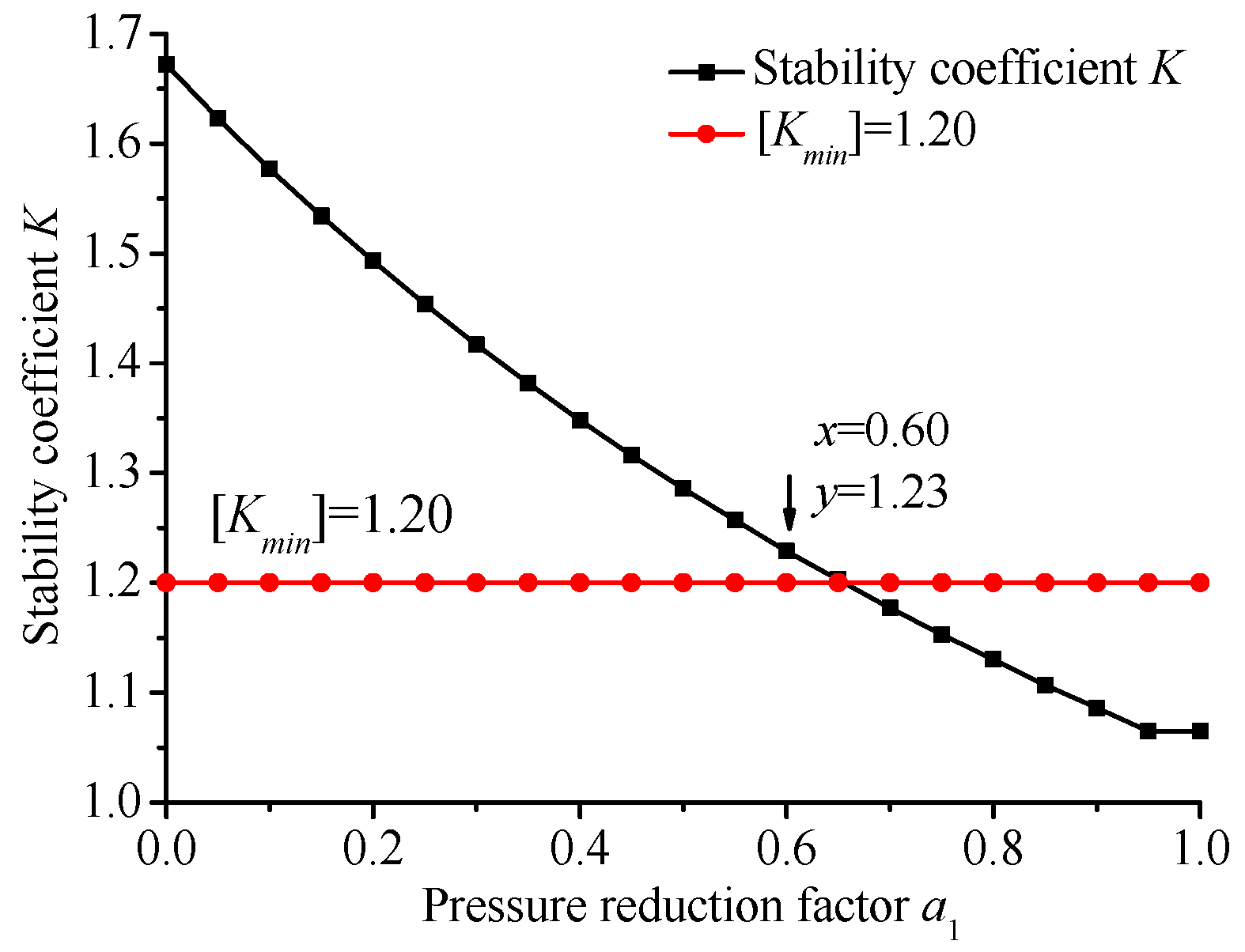
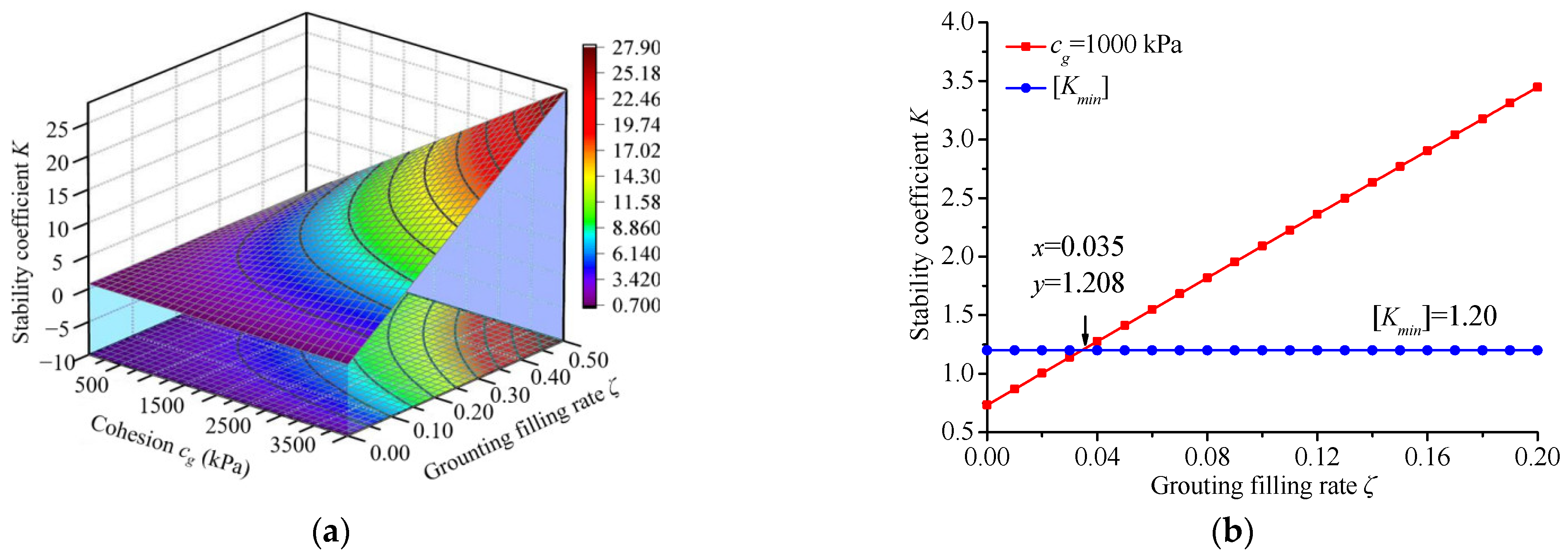

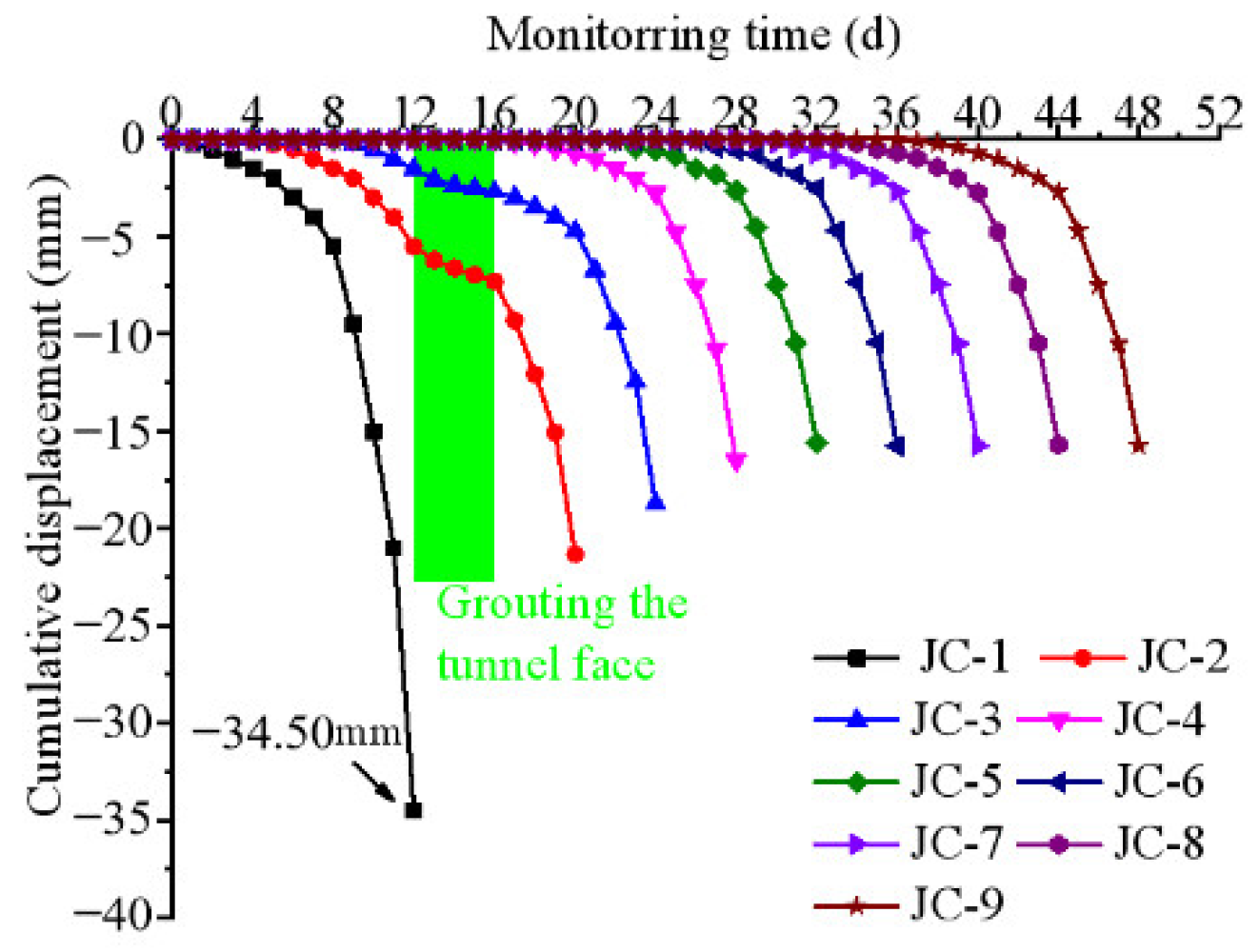
| Tunnels | Left Line | Right Line | Middle Line |
|---|---|---|---|
| Buried depth H (m) | 16.13 | 16.13 | 7.25 |
| Tunnel height D (m) | 7.11 | 7.11 | 7.56 |
| Tunnel width B0 (m) | 7.06 | 7.06 | 7.06 |
| Upper step height D0 | 3.71 | 3.71 | 3.71 |
| Equivalent width l0 (m) | 5.80 | 5.80 | 5.80 |
| Bottom of core soil b1 (m) | 3.80 | 3.80 | 3.80 |
| Height of core soil h (m) | 1.80 | 1.80 | 1.80 |
| Length of unsupported section Le (m) | 0.50 | 0.50 | 0.50 |
| Surrounding Rock Parameters | Artificial Fill | Silty Clay | Sandy Mudstone |
|---|---|---|---|
| Thickness (m) | 15.10~22.4 | 0.40~3.50 | 6 |
| Density (kN/m3) | 17 | 18 | 20 |
| Porosity (%) | 50 | 47 | 20 |
| Cohesion (kPa) | 15 | 30 | 60 |
| Internal friction angle (°) | 20 | 35 | 40 |
| Lateral pressure coefficient | 0.357 | 0.293 | 0.234 |
Publisher’s Note: MDPI stays neutral with regard to jurisdictional claims in published maps and institutional affiliations. |
© 2022 by the authors. Licensee MDPI, Basel, Switzerland. This article is an open access article distributed under the terms and conditions of the Creative Commons Attribution (CC BY) license (https://creativecommons.org/licenses/by/4.0/).
Share and Cite
Zhou, G.-N.; Yang, T.-T.; Sun, Z.; Li, H.; Cheng, Y.; Song, Z.-P.; Han, J.-J. Investigation of Quantitative Evaluation Method and Engineering Application of Shallow Buried Tunnel Face Stability. Appl. Sci. 2022, 12, 6656. https://doi.org/10.3390/app12136656
Zhou G-N, Yang T-T, Sun Z, Li H, Cheng Y, Song Z-P, Han J-J. Investigation of Quantitative Evaluation Method and Engineering Application of Shallow Buried Tunnel Face Stability. Applied Sciences. 2022; 12(13):6656. https://doi.org/10.3390/app12136656
Chicago/Turabian StyleZhou, Guan-Nan, Teng-Tian Yang, Ze Sun, Heng Li, Yun Cheng, Zhan-Ping Song, and Jing-Jing Han. 2022. "Investigation of Quantitative Evaluation Method and Engineering Application of Shallow Buried Tunnel Face Stability" Applied Sciences 12, no. 13: 6656. https://doi.org/10.3390/app12136656






